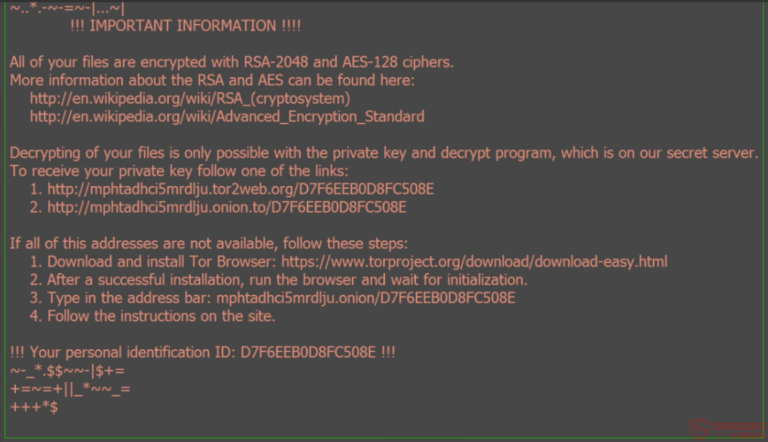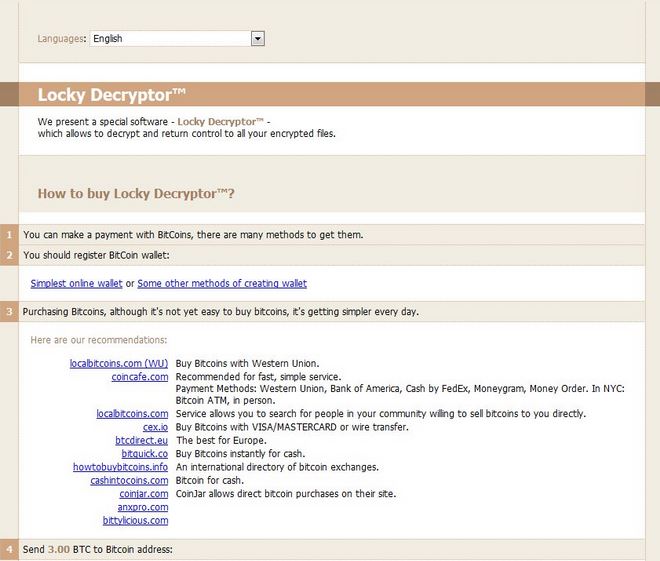This article will help you remove .osiris file extension virus (Locky ransomware) successfully. Follow the ransomware removal instructions below carefully.
Another version of the top 3 malware ever to be recorded, Locky Ransomware has come out into the open in a massive spam campaign infecting users as of now. The ransom malware aims to encrypt the files on the users’ computers after which changes their names and adds the .osiris file extension to the files. The algorithms used by the ransomware virus are RSA-2048 and AES-128 and they make sure the files become no longer openable until the victim of the virus pays the ransom of 3 BTC to restore the files, which is not guaranteed. Continue reading this article in order to familiarize yourself with the latest Locky iteration and learn what is the best way to eliminate it permanently from your computer.

Threat Summary
| Name | Locky .osiris |
| Type | Ransomware, Cryptovirus |
| Short Description | The .osiris virus encrypts your data and then displays a ransom message with instructions for payment. |
| Symptoms | Encrypted files by .osiris Locky will have the .osiris expansion after their name and their names changed with random characters appended to them. |
| Distribution Method | Spam Emails, Email Attachments, malicious .xls files, .htm Files, .js files, .ZIP archives |
| Detection Tool |
See If Your System Has Been Affected by malware
Download
Malware Removal Tool
|
User Experience | Join Our Forum to Discuss Locky .osiris. |
| Data Recovery Tool | Windows Data Recovery by Stellar Phoenix Notice! This product scans your drive sectors to recover lost files and it may not recover 100% of the encrypted files, but only few of them, depending on the situation and whether or not you have reformatted your drive. |

.osiris Locky Virus – What Is New
The clever individuals who have coded Locky ransomware have become stuck to a method which is very well-known to work best, even though a little outdated – spam e-mails. The crooks have a wide network of resources to spread the malware and the e-mail messages they use are very cleverly designed fake messages. This tactic is also known as “social engineering” or simply playing the inexperienced user for access to his PC.
What the cyber-criminals behind Locky do is they attack couple of documents among which is a malicious .xls file pretending to be Microsoft excel which may conduct the infection by Locky ransomware using a malicious macro. Accompanying the .xls file are several .txt files just to make the e-mail seem more legitimate. The body of the e-mail discovered by TMMalAnalyst (Twitter) states the following message:
Another e-mail was discovered later and uploaded in Pastebin with those contents:
Dear {name},
Our accountants have noticed a mistake in the payment bill #DEC-12112015.
The full information regarding the mistake, and further recommendations are in the attached document.
Please confirm the amount and let us know if you have any questions.
Attachment: bill5543521.zip -> -W24C24SS543.js
And accompanying this message are the malicious files attached which once clicked on by the user make the successful infection with Locky .osiris inevitable. This is done with the assistance of an extremely large network of distribution hosts:

Are the Botnet Rumors True?
Several rumors surfaced that Locky ransomware has been using the ransomware infection just as an excuse to cause a second infection with an information-stealing botnet malware. For those uninformed, botnet is malware that replicates automatically on a given network hence increasing the impact and it’s “zombie network” of submissive computers to the cyber-criminal controlling it.
So far, Tripwire has reported this event to occur in the .zzzzz iteration of Locky ransomware (previous one to .osiris) and many feel convinced that history shall repeat itself, primarily because not much has changed between the two iterations of the ransomware. So what is expected from this iteration is to repeat the same process – after infecting the victim to connect to an external IP address and make the computer a part of a large-scale bot network. This is extremely dangerous because someone in control may damage or take advantage of a vast number of machines, and even simultaneously damage them in some cases.

How Does The .osiris Locky Virus Work
After the user has been infected via this malicious infection file, whether it is .htm, .js or .xls, the ransomware is already activated on the computer and slips past any real-time defenses and process monitoring services of standard security software.
Then Locky .osiris ransomware may modify the registry sub-key Desktop so that it changes the wallpaper of the infected computer to the default Locky wallpaper:
After this, the .osiris ransomware drops the following files on the infected system:
- OSIRIS-{RANDOM}.htm in %Documents%
- Shtefans1.spe in %Temp%
- Rundll32.exe (malicious executable file pretending to be legitimate rundll process of Windows)
After these files are dropped, the Locky .osiris virus begins the encryption procedure. To successfully encrypt the files on the infected computer, the ransomware virus uses a strong mixture of RSA (Rivest-Shamir-Adleman) and AES(Advanced Encryption Standard) which are ciphers that were confirmed to be used by the government to encode secret files for defensive purposes. These ciphers replace blocks or segments of data on the source code of the encrypted file and this makes it no longer openable. After the .osiris virus encrypts the files, it also respectively ads it’s distinctive extension and random A-Z, 0-9 identification on each encrypted file. The files are reported by Marcelo Rivero (Twitter) to be altered in the following format:
After the user becomes presented with the .hta file which has instructions on how to pay funds, the user is led to a website, advertising Locky Decrypter, just like it’s previous .shit, .zzzzz, .aesir, .odin, .locky and .thor ransomware variants:
Should the user choose to pay the ransom amount, there is no guarantee on whether or not his files will be successfully recovered or not. This is why malware research experts strongly advise against trusting cyber-crooks.
The .osiris virus is still infecting computers to this day and regarded as one of the toughest ransomware viruses.

Remove Locky Ransomware and Restore .Osiris Encrypted Files
The first thing that springs up to mind when removing Locky ransomware is to simply delete any files you see. This is highly inadvisable and may further complicate the situation. Instead, malware researchers strongly advise taking a more surgical approach and removing the malicious files using an advanced malware scanner which automatically and swiftly takes care of Locky without any further damage to the files.
After you have removed Locky’s .osiris ransomware virus, the next step for you is to try and restore your files. But, before restoring the files we strongly urge you to create couple of copies of them and then try the methods we have suggested in step “2. Restore files encrypted by Locky .osiris” below. This way you will not risk the actual files why attempting those alternative solutions. Let us know in the comment section below whether or not the solutions worked and do not hesitate to ask us any questions, we will attempt to help to the best of our abilities.
- Step 1
- Step 2
- Step 3
- Step 4
- Step 5
Step 1: Scan for Locky .osiris with SpyHunter Anti-Malware Tool



Ransomware Automatic Removal - Video Guide
Step 2: Uninstall Locky .osiris and related malware from Windows
Here is a method in few easy steps that should be able to uninstall most programs. No matter if you are using Windows 10, 8, 7, Vista or XP, those steps will get the job done. Dragging the program or its folder to the recycle bin can be a very bad decision. If you do that, bits and pieces of the program are left behind, and that can lead to unstable work of your PC, errors with the file type associations and other unpleasant activities. The proper way to get a program off your computer is to Uninstall it. To do that:


 Follow the instructions above and you will successfully delete most unwanted and malicious programs.
Follow the instructions above and you will successfully delete most unwanted and malicious programs.
Step 3: Clean any registries, created by Locky .osiris on your computer.
The usually targeted registries of Windows machines are the following:
- HKEY_LOCAL_MACHINE\Software\Microsoft\Windows\CurrentVersion\Run
- HKEY_CURRENT_USER\Software\Microsoft\Windows\CurrentVersion\Run
- HKEY_LOCAL_MACHINE\Software\Microsoft\Windows\CurrentVersion\RunOnce
- HKEY_CURRENT_USER\Software\Microsoft\Windows\CurrentVersion\RunOnce
You can access them by opening the Windows registry editor and deleting any values, created by Locky .osiris there. This can happen by following the steps underneath:


 Tip: To find a virus-created value, you can right-click on it and click "Modify" to see which file it is set to run. If this is the virus file location, remove the value.
Tip: To find a virus-created value, you can right-click on it and click "Modify" to see which file it is set to run. If this is the virus file location, remove the value.
Before starting "Step 4", please boot back into Normal mode, in case you are currently in Safe Mode.
This will enable you to install and use SpyHunter 5 successfully.
Step 4: Boot Your PC In Safe Mode to isolate and remove Locky .osiris





Step 5: Try to Restore Files Encrypted by Locky .osiris.
Method 1: Use STOP Decrypter by Emsisoft.
Not all variants of this ransomware can be decrypted for free, but we have added the decryptor used by researchers that is often updated with the variants which become eventually decrypted. You can try and decrypt your files using the instructions below, but if they do not work, then unfortunately your variant of the ransomware virus is not decryptable.
Follow the instructions below to use the Emsisoft decrypter and decrypt your files for free. You can download the Emsisoft decryption tool linked here and then follow the steps provided below:
1 Right-click on the decrypter and click on Run as Administrator as shown below:

2. Agree with the license terms:

3. Click on "Add Folder" and then add the folders where you want files decrypted as shown underneath:

4. Click on "Decrypt" and wait for your files to be decoded.

Note: Credit for the decryptor goes to Emsisoft researchers who have made the breakthrough with this virus.
Method 2: Use data recovery software
Ransomware infections and Locky .osiris aim to encrypt your files using an encryption algorithm which may be very difficult to decrypt. This is why we have suggested a data recovery method that may help you go around direct decryption and try to restore your files. Bear in mind that this method may not be 100% effective but may also help you a little or a lot in different situations.
Simply click on the link and on the website menus on the top, choose Data Recovery - Data Recovery Wizard for Windows or Mac (depending on your OS), and then download and run the tool.
Locky .osiris-FAQ
What is Locky .osiris Ransomware?
Locky .osiris is a ransomware infection - the malicious software that enters your computer silently and blocks either access to the computer itself or encrypt your files.
Many ransomware viruses use sophisticated encryption algorithms to make your files inaccessible. The goal of ransomware infections is to demand that you pay a ransom payment to get access to your files back.
What Does Locky .osiris Ransomware Do?
Ransomware in general is a malicious software that is designed to block access to your computer or files until a ransom is paid.
Ransomware viruses can also damage your system, corrupt data and delete files, resulting in the permanent loss of important files.
How Does Locky .osiris Infect?
Via several ways.Locky .osiris Ransomware infects computers by being sent via phishing emails, containing virus attachment. This attachment is usually masked as an important document, like an invoice, bank document or even a plane ticket and it looks very convincing to users.
Another way you may become a victim of Locky .osiris is if you download a fake installer, crack or patch from a low reputation website or if you click on a virus link. Many users report getting a ransomware infection by downloading torrents.
How to Open .Locky .osiris files?
You can't without a decryptor. At this point, the .Locky .osiris files are encrypted. You can only open them once they are decrypted using a specific decryption key for the particular algorithm.
What to Do If a Decryptor Does Not Work?
Do not panic, and backup the files. If a decryptor did not decrypt your .Locky .osiris files successfully, then do not despair, because this virus is still new.
Can I Restore ".Locky .osiris" Files?
Yes, sometimes files can be restored. We have suggested several file recovery methods that could work if you want to restore .Locky .osiris files.
These methods are in no way 100% guaranteed that you will be able to get your files back. But if you have a backup, your chances of success are much greater.
How To Get Rid of Locky .osiris Virus?
The safest way and the most efficient one for the removal of this ransomware infection is the use a professional anti-malware program.
It will scan for and locate Locky .osiris ransomware and then remove it without causing any additional harm to your important .Locky .osiris files.
Can I Report Ransomware to Authorities?
In case your computer got infected with a ransomware infection, you can report it to the local Police departments. It can help authorities worldwide track and determine the perpetrators behind the virus that has infected your computer.
Below, we have prepared a list with government websites, where you can file a report in case you are a victim of a cybercrime:
Cyber-security authorities, responsible for handling ransomware attack reports in different regions all over the world:
Germany - Offizielles Portal der deutschen Polizei
United States - IC3 Internet Crime Complaint Centre
United Kingdom - Action Fraud Police
France - Ministère de l'Intérieur
Italy - Polizia Di Stato
Spain - Policía Nacional
Netherlands - Politie
Poland - Policja
Portugal - Polícia Judiciária
Greece - Cyber Crime Unit (Hellenic Police)
India - Mumbai Police - CyberCrime Investigation Cell
Australia - Australian High Tech Crime Center
Reports may be responded to in different timeframes, depending on your local authorities.
Can You Stop Ransomware from Encrypting Your Files?
Yes, you can prevent ransomware. The best way to do this is to ensure your computer system is updated with the latest security patches, use a reputable anti-malware program and firewall, backup your important files frequently, and avoid clicking on malicious links or downloading unknown files.
Can Locky .osiris Ransomware Steal Your Data?
Yes, in most cases ransomware will steal your information. It is a form of malware that steals data from a user's computer, encrypts it, and then demands a ransom in order to decrypt it.
In many cases, the malware authors or attackers will threaten to delete the data or publish it online unless the ransom is paid.
Can Ransomware Infect WiFi?
Yes, ransomware can infect WiFi networks, as malicious actors can use it to gain control of the network, steal confidential data, and lock out users. If a ransomware attack is successful, it could lead to a loss of service and/or data, and in some cases, financial losses.
Should I Pay Ransomware?
No, you should not pay ransomware extortionists. Paying them only encourages criminals and does not guarantee that the files or data will be restored. The better approach is to have a secure backup of important data and be vigilant about security in the first place.
What Happens If I Don't Pay Ransom?
If you don't pay the ransom, the hackers may still have access to your computer, data, or files and may continue to threaten to expose or delete them, or even use them to commit cybercrimes. In some cases, they may even continue to demand additional ransom payments.
Can a Ransomware Attack Be Detected?
Yes, ransomware can be detected. Anti-malware software and other advanced security tools can detect ransomware and alert the user when it is present on a machine.
It is important to stay up-to-date on the latest security measures and to keep security software updated to ensure ransomware can be detected and prevented.
Do Ransomware Criminals Get Caught?
Yes, ransomware criminals do get caught. Law enforcement agencies, such as the FBI, Interpol and others have been successful in tracking down and prosecuting ransomware criminals in the US and other countries. As ransomware threats continue to increase, so does the enforcement activity.
About the Locky .osiris Research
The content we publish on SensorsTechForum.com, this Locky .osiris how-to removal guide included, is the outcome of extensive research, hard work and our team’s devotion to help you remove the specific malware and restore your encrypted files.
How did we conduct the research on this ransomware?
Our research is based on an independent investigation. We are in contact with independent security researchers, and as such, we receive daily updates on the latest malware and ransomware definitions.
Furthermore, the research behind the Locky .osiris ransomware threat is backed with VirusTotal and the NoMoreRansom project.
To better understand the ransomware threat, please refer to the following articles which provide knowledgeable details.
As a site that has been dedicated to providing free removal instructions for ransomware and malware since 2014, SensorsTechForum’s recommendation is to only pay attention to trustworthy sources.
How to recognize trustworthy sources:
- Always check "About Us" web page.
- Profile of the content creator.
- Make sure that real people are behind the site and not fake names and profiles.
- Verify Facebook, LinkedIn and Twitter personal profiles.






